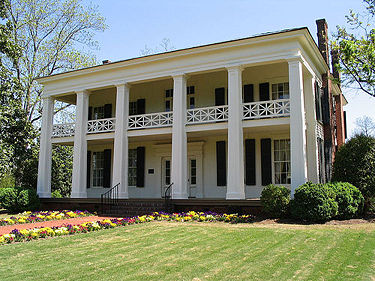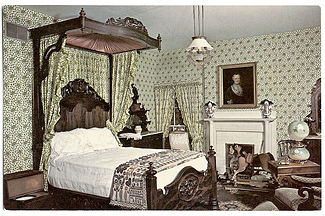Arlington Antebellum Home & Gardens: Difference between revisions
No edit summary |
No edit summary |
||
| Line 12: | Line 12: | ||
When Mudd died in [[1884]], Colonel [[Henry Debardeleben]] purchased it as an investment. He never lived there, and soon sold it to [[F. H. Whitney]] of Cass County, Iowa, who converted it for use as a boarding house. It served that function until it was purchased in [[1902]] by [[Robert Munger]], owner of [[Continental Gin Company]] which manufactured cotton gins in [[Avondale]]. Munger died in [[1924]] leaving the estate to his daughter, [[Ruby Montgomery|Ruby]] and her husband, [[Alex Montgomery]]. They resided there for nearly three decades, putting the property up for sale in [[1952]]. | When Mudd died in [[1884]], Colonel [[Henry Debardeleben]] purchased it as an investment. He never lived there, and soon sold it to [[F. H. Whitney]] of Cass County, Iowa, who converted it for use as a boarding house. It served that function until it was purchased in [[1902]] by [[Robert Munger]], owner of [[Continental Gin Company]] which manufactured cotton gins in [[Avondale]]. Munger died in [[1924]] leaving the estate to his daughter, [[Ruby Montgomery|Ruby]] and her husband, [[Alex Montgomery]]. They resided there for nearly three decades, putting the property up for sale in [[1952]]. | ||
Members of the [[Elyton-West End-Powderly Civic Club]], led by [[Fred Melof]], rallied numerous civic organization to petition Birmingham's Department of Parks and Recreation to purchase the house as a Confederate memorial and museum. Mayor [[Cooper Green]] and commissioner [[Jimmy Morgan]] supported their efforts, but declined to commit funds from the city budget. A steering committee headed by [[Morgan Smith]] began raising money to make the purchase, which was completed in [[1953]] for $53,000. The house was restored and furnished by the [[Arlington Historical Association]] and soon became one of the signature landmarks for visitors to Birmingham. | |||
Tours of the home are available on Tuesdays through Sundays, and the restored tea-room can be reserved for private parties. The rooms are furnished with antiques from the Antebellum period, many of them original to the house. The home also displays a notable collection of 19th century decorative arts and paintings. | Tours of the home are available on Tuesdays through Sundays, and the restored tea-room can be reserved for private parties. The rooms are furnished with antiques from the Antebellum period, many of them original to the house. The home also displays a notable collection of 19th century decorative arts and paintings. | ||
| Line 24: | Line 24: | ||
==References== | ==References== | ||
* "[http://www.birminghamrewound.com/features/Arlington%20(6-52).jpg Arlington up for sale— Purchase of landmark for shrine urged]" (June 1952) {{BN}} - via [[Birmingham Rewound]] | * "[http://www.birminghamrewound.com/features/Arlington%20(6-52).jpg Arlington up for sale— Purchase of landmark for shrine urged]" (June 1952) {{BN}} - via [[Birmingham Rewound]] | ||
* "[http://www.birminghamrewound.com/features/Arlington%20%2807-52%29.jpg 'Buy Arlington' citizen fund drive opens]" (July 1952) {{BN}} - via [[Birmingham Rewound]] | |||
* Satterfield, Carolyn Green (1976) ''Historic Sites of Jefferson County, Alabama''. Birmingham: Jefferson County Historical Commission., p. 49 | * Satterfield, Carolyn Green (1976) ''Historic Sites of Jefferson County, Alabama''. Birmingham: Jefferson County Historical Commission., p. 49 | ||
* Jaffe, Dana (December 15, 2008) "Birmingham antebellum Arlington house and museum gets makeover." {{BN}} | * Jaffe, Dana (December 15, 2008) "Birmingham antebellum Arlington house and museum gets makeover." {{BN}} | ||
Revision as of 09:25, 1 July 2012
Arlington Antebellum Home & Gardens is a mansion built by Stephen Hall and greatly enlarged, in the Greek Revival style, for Judge William S. Mudd. Mudd went on to join with the Elyton Land Company in the founding of Birmingham in 1871. The house, which formerly commanded hundreds of acres, is currently located on a 6-acre lot at 331 Cotton Avenue Southwest in the Arlington-West End neighborhood of Birmingham. Owned by the City of Birmingham, it serves as a historical interpretive museum and reception hall.
History
Hall, a trustee of the Jefferson Academy, built a four-room, two story farmhouse on 475 acres in the corporate limits of Elyton which he had purchased in 1822 from William O. Tarrant and John Burford, Sr. A blacksmith's shop was also built on the property. At his death, the property was inherited by his son, Samuel, who depleted his wealth, forcing the sale of the house and grounds at auction in 1842.
Mudd bought the estate at auction and, with the help of his slaves, enlarged the four-room house into a grand eight-room mansion with a two-story gallery supported by six square columns. The addition extended the existing house eastward by building onto the front of the farmhouse and creating a new front entry to the north. A shallow hipped roof was built over the resulting two-story rectangular mansion. Two chimneys were added on the east end, mirroring the two on the west and providing a hearth for each chamber. The finished house was dubbed "Arlington" by Mudd, perhaps a reference to the estate in Virginia where Colonel Robert E. Lee, a hero of the Mexican War, made his home.
From 1843 to 1848, Mudd served in the Alabama legislature. In 1856 he was elected Circuit Judge, a position he held until his health forced retirement in 1883. During Wilson's Raid in the Spring of 1865, the house was commandeered as a temporary headquarters for General James H. Wilson and his staff. While there, Wilson made plans for General John T. Croxton to lead a detached brigade to Tuscaloosa to burn the University of Alabama, which had trained cadets for the Confederacy and was operating a hospital for soldiers. Wilson's use of the home helped spare it from destruction.
When Mudd died in 1884, Colonel Henry Debardeleben purchased it as an investment. He never lived there, and soon sold it to F. H. Whitney of Cass County, Iowa, who converted it for use as a boarding house. It served that function until it was purchased in 1902 by Robert Munger, owner of Continental Gin Company which manufactured cotton gins in Avondale. Munger died in 1924 leaving the estate to his daughter, Ruby and her husband, Alex Montgomery. They resided there for nearly three decades, putting the property up for sale in 1952.
Members of the Elyton-West End-Powderly Civic Club, led by Fred Melof, rallied numerous civic organization to petition Birmingham's Department of Parks and Recreation to purchase the house as a Confederate memorial and museum. Mayor Cooper Green and commissioner Jimmy Morgan supported their efforts, but declined to commit funds from the city budget. A steering committee headed by Morgan Smith began raising money to make the purchase, which was completed in 1953 for $53,000. The house was restored and furnished by the Arlington Historical Association and soon became one of the signature landmarks for visitors to Birmingham.
Tours of the home are available on Tuesdays through Sundays, and the restored tea-room can be reserved for private parties. The rooms are furnished with antiques from the Antebellum period, many of them original to the house. The home also displays a notable collection of 19th century decorative arts and paintings.
The house serves also as a decorative arts museum, featuring a collection of 19th-century furniture, textiles, silver, and paintings. Arlington has gardens and a restored garden room named the Tea Room that is used for private and club events such as weddings, meetings, and food-service events.
The site was added to the National Register of Historic Places in 1970. The ashes of former mayor George Seibels, who died in 2000, are interred at Arlington.
In 2008 the exterior of the house was repaired and repainted. Visitors' restrooms were enlarged to accommodate the disabled and ramps were constructed to improve wheelchair access to the restaurant, gift shop and museum. Additional work planned for 2009 includes opening the restaurant up toward the formal garden and renovating its interior.
References
- "Arlington up for sale— Purchase of landmark for shrine urged" (June 1952) The Birmingham News - via Birmingham Rewound
- "'Buy Arlington' citizen fund drive opens" (July 1952) The Birmingham News - via Birmingham Rewound
- Satterfield, Carolyn Green (1976) Historic Sites of Jefferson County, Alabama. Birmingham: Jefferson County Historical Commission., p. 49
- Jaffe, Dana (December 15, 2008) "Birmingham antebellum Arlington house and museum gets makeover." The Birmingham News
External link
- Arlington Antebellum Home & Gardens at InformationBirmingham.com

